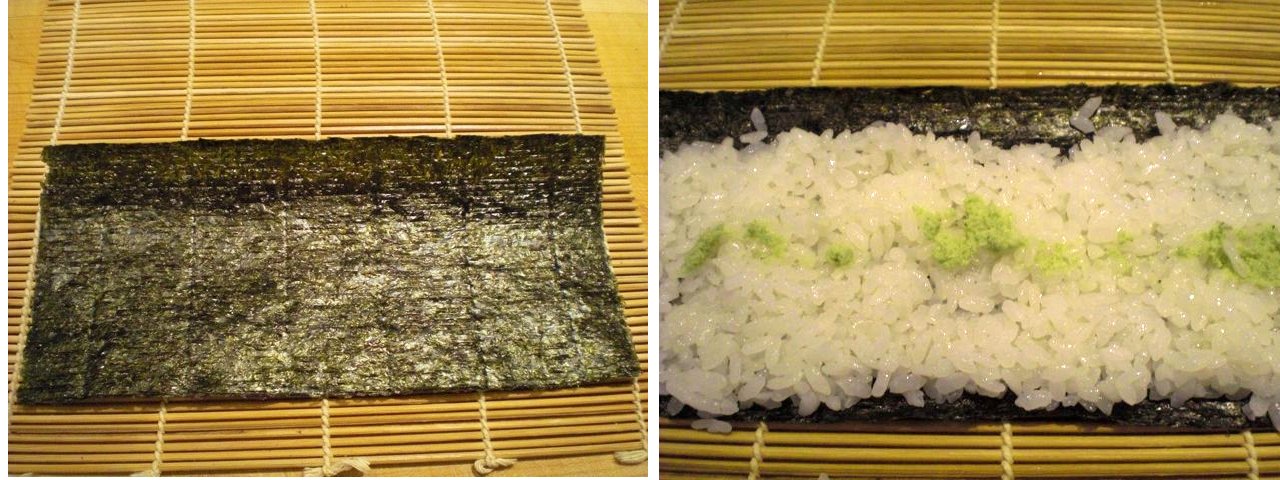At home, I usually make sushi rolls 巻き寿司 or scattered sushi "chirashi" ちらし寿司 but not "nigiri" 握り寿司 which requires the skill that I do not have. Among the sushi rolls, one is called futomaki 太巻き. I actually make a deluxe (?) version which our sushi chef, Hajime, at the long-defunct Japanese restaurant, Mikado, showed me how to make many years ago. This deluxe version uses two nori sheets with both uramaki 裏巻き (the rice layer facing outside) and omotemaki 表巻き (the rice layer inside and the nori outside) combined into one roll. I am sure I will post it sometime in the future. Another roll I make often is California roll since it is uramaki, it is easier to make (it will not come apart easily like a regular hosomaki 細巻き and the ingredients are readily available at any time in the U.S.- avocado and crab meat.
This time I made a classic Tekka roll 鉄火巻き using an akami 赤身 portion of the tuna and "Uni no gunkan-maki" 雲丹の軍艦巻き.

First, I make sushi rice. Since my wife (and myself) like a good vinegar flavor, I add as much sushi vinegar (from the bottle, but one which contains real rice vinegar such as Mizkan ミツカン brand ) as the rice can absorb.
Next, I make the base for the Uni sushi called "Gunkan-maki" 軍艦巻き, "gunkan" means a miitary ship since it resembles the hull of a naval vessel (see the flotilla in the lower left image). I just make a small oval shaped rice ball and then wrap a nori sheet (cut 1/2 along the long axis to make a half-width nori sheet and then cut long strips with 1/3 of the width of the half sheet). I use a rice kernel to secure the end of the nori strip to make the nori-rice container as in the lower left image (another technique I learned from Hajime the sushi chef). The lower right is a tray of uni from Catalina.
To make the tuna tekka maki, I cut a long rectangle of akami of tuna for tekka maki. I put a small amount of real wasabi on a small plate.

I cut a full sheet of nori 海苔 in half and place in on the bamboo sushi mat or makisu 巻き簾 (lower left) and spread the sushi rice in a thin layer and smear wasabi along the mid-line. I make sure to leave a 1/2 inch of nori at the far end uncovered, otherwise, the roll will not close or stay closed. To prevent the rice from sticking to my hands, I use cold water with a dash of vinegar in it to moisten my hand. I shake off or wipe off excess moisture from my hands using a tea towel just before touching the rice every time. This keeps my hands cold and prevents the rice from sticking.


 This was lunch but we had a one small glass of cold sake. (The taste of vinegared rice demands the accompanying taste of sake). It may not look as pretty as the ones prepared by a pro but this tasted very good. Certainly 100% better than any box of sushi bought at the grocer store.
This was lunch but we had a one small glass of cold sake. (The taste of vinegared rice demands the accompanying taste of sake). It may not look as pretty as the ones prepared by a pro but this tasted very good. Certainly 100% better than any box of sushi bought at the grocer store.
I place the rectangles of akami on top of the stripe of smeared wasabi. Since I took these pictures myself, I cannot show how I made the roll more precisely using pictures. Here goes a verbal description: with the edge of nori covered in rice close to me, while holding the tuna with my index fingers in the middle of the roll, I aim the rice covered edge to meet the far edge of the rice layer. I then pull back slightly so the two rice edges make good contact. Then I roll forward again so the nori tab covers the rice seam. (This step is what assures that the pieces of the roll hold together after they are cut). Once the seal has been made, I squeeze the bamboo mat to form the roll.
Anyway here is the end result. The rice should not come out at the bottom seam and the nori should wrap all around. After making two rolls I used a thin bladed sharp knife, put the rolls next to each other and cut both rolls simultaneously. (I do not have a Japanese yanagi-ba 柳刃 so I use a long "Swedish" fillet knife from Global - for slicing smoke salmon, I suppose - but works very well). I dip the blade into the water vinegar mixture and shake off the excess water before slicing the rolls (all this is to prevent the rice from sticking to the blade of the knife). Imitating a sushi chef, I cut the rolls in half first and then cut the each half into thirds.

